It happens every so often—someone claims to have found some lost treasure of a movie. In fact, about 15 years ago a frame blow-up of the supposed main title of Tod Browning’s London After Midnight (1927) made the rounds of movie sites on the Web. It was quickly revealed to be a hoax. Well, the London After Midnight rumors are back and this time there seems to at least possibly be some substance to them. Ain’t It Cool News has run two pieces on the film’s purported existence with a link to the message boards where it started. And with a long-believed-lost print of the complete version of Fritz Lang’s Metropolis recently turning up in a South American archive, the idea of a new discovery feels less far-fetched than usual right now.
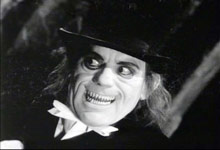
For those who don’t follow these things, London After Midnight is the cineaste’s holy grail of lost movies—even more so for horror movie afficionados. Even though it turns out to be a shaggy bat story (Hollywood was not yet convinced that audiences would accept the supernatural), it’s the first American vampire film—and a key work in the filmographies of both its director, Tod Browning, and its star, Lon Chaney.
As far as American film is concerned, Browning is the father of the horror film. His first 100 percent bonafide horror picture may not come until 1931 with Dracula, but his tendency toward the macabre, the weird and even the just plain unpleasant were always in evidence. Films like The Unholy Three (1925), The Unknown (1927), The Show (1927) and West of Zanzibar (1928) were not exactly your average fare. These are odd, frequently sado-masochistic works that inhabit a strange world of their own. It’s a world that has much in common with the seedier side of carnival and sideshow life—where many of the stories are set—and one in which the decay of the settings and the characters themselves is conveyed by insert shots of scuttling insects, spiders, lizards and nocturnal animal life.
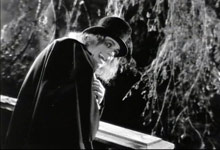
In many respects, Browning is a typical American silent movie director, relying far too much on a nailed-down camera. At first glance, Browning’s films seem almost anti-cinematic—stodgy even. For years, I wrote Browning off as a man with great ideas that he couldn’t quite pull off. I was wrong. Two things happened. A friend sat me down and made me watch Dracula with an eye toward the subtlety of the compositions. Then the Spanish-language version of Dracula (another “lost” film)—directed by George Melford—was discovered and it was possible to look at two takes by different filmmakers working from the same screenplays and using the same sets. The comparison was revelatory.
The Melford film, while occasionally more coherently structured (it runs nearly 30 minutes longer), and boasting a handful of technical flourishes that catch the eye, has none of the atmosphere of the Browning film. There’s no sign of what was once tagged the “misty poetry” of Browning’s version and no sense of dread to the proceedings. In part, this stems from Melford being saddled with Carlos Villarias in the title role rather than Bela Lugosi. (If you can envision Topo Gigio playing Dracula, you’re close to Villarias’ portrayal.) But there’s a good deal more in terms of atmosphere—and this is where Browning scores.
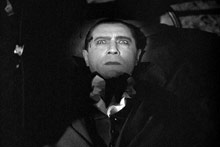
If you look at Browning’s works with an eye toward their atmosphere, they become a remarkable set of films. Whether its the thick cigar smoke and sense of confined sleaziness of the carnival in The Unholy Three, the lizards crawling through the jungle muck in West of Zanzibar, or the inexplicable spurts of mist rising from the earth of the crypt in Dracula, it’s all about the atmosphere—an all-enveloping sense of another world, a sinister world. It’s a world that looks like our own, but somehow isn’t. The cumulative power of the films is unsettling in a way that more overt horror rarely is.
The question is whether that will hold true of London After Midnight if the film is finally in our grasp after all these years. The smart money tends toward the belief that the major response to it will be one of disappointment. I’m far less certain of that than I would have been a few years ago. Let’s consider the situation.
The film was withdrawn from the world in 1935 when Browning chose to remake it as Mark of the Vampire. As was common practice with MGM, the idea was to prevent anyone being able to make a negative comparison by being sure no one would see the old version. (They pulled the same stunt when they bought properties from other studios, too, which is why Rouben Mamoulian’s Dr. Jekyll and Mr. Hyde (1931) and two James Whale pictures, Waterloo Bridge (1931) and Show Boat (1936), went unseen for years.) As a result, by the time real interest in the film started up, London After Midnight had gone unseen for over 20 years and probably nearer 30, since most memories of it date back to 1927. I don’t know about the rest of you, but I’m not that inclined to take memories of it not being very good from that great a distance at face value. (Yet I know one person who “knows” the film isn’t any good because his grandmother didn’t like in 1927—and told him so 50 years or more later.)
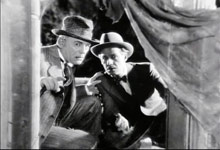
The first “official” warning that London After Midnight was likely to be a disappointment were it ever found came in 1972 from film historian William K. Everson in his book Classics of the Horror Film. Several things need to be considered here—not the least of which is that Everson had never seen the film. More than that, this was written just after Everson had been disappointed with Michael Curtiz’ Mystery of the the Wax Museum (1933), which had been only recently been discovered after years of being considered lost. Beyond this, however, is the fact that most of us—and to some degree, Everson—had seen very little of Browning’s silents at the time. That’s changed in the meantime.
Regardless of how one feels about Browning’s films, there’s been much more chance to see the ones that are known to exist these days. It’s no longer a case of guesswork. The film can now be firmly placed as coming directly after The Show and The Unknown, two of Browning’s most accomplished silents. Is there any reason to suspect that there was a sudden dropping off in quality with this one? Not really—and with material as ripe with potential as London After Midnight, there’s some reason for at least cautious optimism.
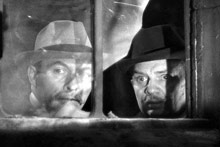
At the same time, it’s difficult not to admit that a great many films starring Chaney promise a lot more than they deliver based on the stills from them. For my generation, Chaney was turned into a cinematic god not by the films themselves so much, but by the tantalizing stills reproduced in Famous Monsters of Filmland magazine by the publication’s editor Forrest J Ackerman, who accompanied the stills with the phrase, “Lon Chaney shall not die!” Who were we to argue? We’d seen few, if any, of the films—just these amazing photographs of the great man in a variety of bizarre make-ups. The films themselves—well among other things, the make-ups may have been grotesque, but the movies weren’t horror pictures for the most part.
In the case of the Browning collaborations they were often creepy and often boasted a degree of horrific content, but the only of the Chaneys that truly qualified as horror were Wallace Wosley’s A Blind Bargain (1922)—another lost film—and Rupert Julian’s The Phantom of the Opera (1925). Ironically, despite Chaney’s make-up, the magnificent sets and a couple great set-pieces (one of which, the chandelier scene, is botched), Phantom is quite frankly not a very good movie. Roland West’s The Monster (1925), despite its title, is actually an old dark house comedy thriller that bizarrely seems to be a parody of the “mad scientist” movie—a genre that hadn’t actually been invented at the time.
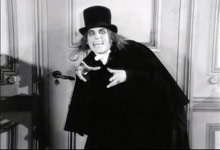
Of Chaney’s make-ups, the most famous (deservedly so) is his Erik in Phantom of the Opera, probably followed (somewhat less deservedly) by his Quasimodo in The Hunchback of Notre Dame (1923). And then there’s The Man with the Beaver Hat as his “vampire” in London After Midnight is called. It probably depends on the individual whether this undeniably striking creature is absolutely terrifying or somewhat amusing. The case for terrifying has not been helped by uses of stills for comedic intent over the years. I think the first time I ever saw the Beaver Hat gent, it was the shot of Chaney by the door with his hands spread apart and the caption read, “I’m going out for a pastrami sandwich this thick.” This is not conducive to terror.
The truth of the matter, I think, lies between the two. The make-up is over-the-top and the facial expressions in the stills (in the stills, mind you) are…well, let’s say of the broader school of acting. At the same time, those rows of pointed teeth are pretty unnerving and all in all, the character (who owes something to John Barrymore’s 1920 incarnation of Mr. Hyde) is the stuff of nightmares—and nightmares are the soul of Browning’s atmospherics. I wouldn’t call the make-up realistic in any sense of the word, but I doubt that anyone would care to run into this guy in a dark hallway.
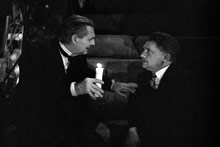
There are two futher reasons why London After Midnight may be better than what we’ve been conditioned to expect. A few years ago, a special “recreation” of the film was done using stills and the movie’s screenplay. The results were interesting, but not exactly compelling viewing—in large part due to the overuse of some stills, zooming in and out on the images to attempt a sense of movement and the complete lack of pace inherent in any such undertaking. On the one hand, it can be argued that the film itself will have to be better than this presentation, but there’s also the fact that the recreation makes certain things clear about the film—especially as concerns its relationship to the readily available Mark of the Vampire.
Mark of the Vampire—which is working its way to the top of my list of Browning’s talkies, especially in terms of atmosphere—is a fairly close remake. Certain changes have been made, starting with moving the film from London to rural Czechoslovakia, effectively turning the old dark house of the original into an old dark castle. The alteration also provides room for colorful gypsy and peasant characters and all the Old Country superstitions that implies. Also, the passage of time (read: Dracula has been made) removes the necessity of the elaborate explanations of what vampires are.
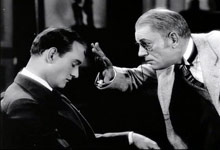
The biggest change, however, lies in the removal of the original’s fairly transparent stunt of having Chaney’s Prof. Burke turn out to also be the Man with the Beaver Hat. The stills make it obvious that every time Burke is in the group of people watching a scene with the other character, a double is being employed (necessary to keep the plot at least vaguely believable) because he’s always shown from the back. That this ever fooled anyone—since the marketing was heavily centered on Chaney’s vampire make-up—seems unlikely, though the fact that Chaney wasn’t just playing more than one character but was a character impersonating another character in the course of the story may have offered some surprise.
For the remake, Chaney’s role becomes three roles. His Inspector Burke is now a separate character played by Lionel Atwill. The role the detective assumes for his investigation has become a separate, more Van Helsing-styled vampire hunter named Prof. Zalen and is played with enthusiastically un-kosher verve by Lionel Barrymore. The vampire is now Count Mora (a bit less of a mouthful than The Man with the Beaver Hat) and is, of course, played by Bela Lugosi in one of his most unnerving performances, made more so by the fact that he never speaks.
The concept of Count Mora and his daughter, Luna (Carroll Borland), as originally planned is one of the most perverse in Browning’s filmography. The idea was that Count Mora became a vampire after committing suicide over an incestuous relationship with his daughter (I’m not exactly sure why she also became a vampire). Now, there was no way this was getting past the Production Code—and it didn’t. All that’s left of the idea is the now inexplicable bullet wound in Count Mora’s temple.
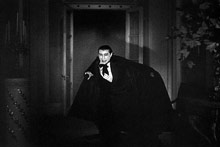
Otherwise, the two films are very similar, as witness the comparison stills at the side. Browning elaborates on the vampires descending the stairs, but the approach is the same. In both cases, the vampires are seemingly out on a late night prowl—though in Mark only Luna figures in what the servants witness. (In both cases, there’s the inescapable question of just how the characters knew someone they could scare would happen to be passing—an aspect that crops up on several occasions.) The servants have understandably similar reactions.
An apparently more involved scene with Chaney’s vampire in the upstairs hallway of the heroine’s house is duplicated in part with Lugosi. In fact, this brief bit in Mark of the Vampire is one of the scariest of all Lugosi’s vampire incarnations on the screen. A sequence where Chaney and Henry B. Walthall spy on what might be called “the vampires at home” is copied to the letter. The hypnotism scenes in London After Midnight find a parallel scene in Mark of the Vampire and so on. The denouement in the same in both cases, too, and that is probably at the heart of the idea of the inevitability of London After Midnight being a disappointment, because it has served as a cudgel against Mark of the Vampire in horror film circles for as long as I can remember.
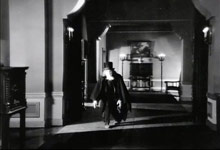
The whole concept of the “rational explanation” comes across as a cheat to many viewers. The fact that the rational explanation is hardly rational—merely non-supernatural—may or may not play a part. If it does then there’s a chance that London After Midnight—apart from the idea of Inspector Burke, Prof. Burke and the Man with the Beaver Hat all being the same person (is this guy a detective or a frustrated ham actor?)—may have the edge. At least the method of murder made to look like suicide is easier to swallow than murder made to look like vampires in the remake. (Back in ‘72, Everson sagely noted that the method must have proved lengthy, tedious and “ultimately rather messy.”) Nonetheless, the whole idea that everything we’ve seen has been staged in order to trap a murderer is not only preposterous, it suggests an expenditure of tax-payer money that would give even the most corrupt departmental heads second thoughts.
Ironically, when Mark of the Vampire came out in 1935 one of the things that was praised was that it departed from the usual horror film by virtue of its clever ending! (Of course, back then movies weren’t in constant circulation and there was no such thing as home video, so after eight years the source of this cleverness had receded into dim memory.) Horror afficionados of a later day took a much dimmer view—and have continued to do so. There’s also a case to be made that horror afficonados have a great deal of trouble getting over what seemed like “a dirty gyp” when they were ten years old, but that’s a separate issue.
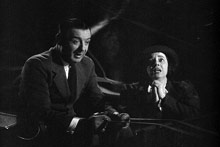
Whether or not London After Midnight will actually measure up to—much less surpass—Mark of the Vampire is another question. The incredibly heavy mood and atmosphere of Mark is going to be hard to equal. The misty, doom-laden world of strange fog and faces at windows, and general sense of unwholesomeness of Mark is so pervasive that it seems unlikely. Then again, London After Midnight will undoubtedly come with a musical score, and part of the otherworldliness of Mark lies in its complete lack of music (unusual in 1935) and the use of strange, moaning wind sounds on its track in its stead. The film even sounds nightmarish.
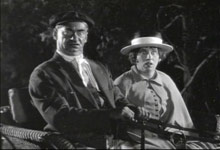
One thing the reconstruction of stills doesn’t convey at all is whether or not London After Midnight will offer those extra little frissons of Browning’s array of odd (often indefinable) and unpleasant animal and insect life that are so much a part of his approach to atmosphere. There is certainly no suggestion of it in the photographs, though that’s not surprising, since these are almost invariably insert shots in the films. (The ghostly appearance of a white Borzoi moving through the graveyard in Mark is a notable exception.) If they are absent, however, the film will suffer for it, I think.
The real question now is whether or not we’re really on the verge of seeing this film or if this is just a rumor that’s going to evaporate like Browning’s dry-ice mists. Sure, it may indeed be a disappointment, but, you know, it’d be pretty darn terrific to find out.
If you want to follow the trail of rumors, start here.



Although I would argue (as the LAM article writer seems to believe) that the Holy Grail for cineastes is the missing footage from GREED, I wouldn’t get too excited about this “discovery”. If it were genuine, film preservationists such as Kevin Brownlow and David Shepard would be all over it and there would be headlines as big as those for the METROPOLIS missing footage. It is more than likely another red herring along the lines of the “recently rediscovered” Murnau 4 DEVILS. I would love to be proven wrong but I don’t think I will be.
Excellent point about the atmospherics in Browning’s films. He was truly a product of the silent era and a first rate visual stylist in the way his films were composed as opposed to how they were shot but, as you pointed out, the look of his films are probably too subtle for today’s viewers assuming they would have the patience for them in the first place. Browning always complained that the final release version of DRACULA was altered from his original concept with more emphasis placed on the stage play since that’s what Laemmle paid for. Years later he refused to watch it on TV calling it a travesty. Still there’s that marvelous first half and the demonic close-up of Lugosi’s face in the second half. I’ve always wondered if the staking off camera was added after the picture was wrapped because of censorship issues even though it’s a pre-Code film.
Although I would argue (as the LAM article writer seems to believe) that the Holy Grail for cineastes is the missing footage from GREED
It might be a little genre specific, but there’s one real difference in London After Midnight‘s favor for me — I actually want to see it. I could be pretty content never seeing Greed again in any form, but that’s just me.
I wouldn’t get too excited about this “discovery”. If it were genuine, film preservationists such as Kevin Brownlow and David Shepard would be all over it and there would be headlines as big as those for the METROPOLIS missing footage.
The catch here — assuming there is one — is that it’s only kinda found. Large parts of the guy’s story don’t make a lot of sense. The only thing that makes me a little hopeful is that I know the guy who backs up part of the story, and I don’t see him being in on a scam. I could, however, imagine him being wrong. I do, however, enjoy the user comments on Ain’t It Cool News. They so clearly represent horror film fandom as I know it (and it ain’t pretty).
Browning always complained that the final release version of DRACULA was altered from his original concept with more emphasis placed on the stage play since that’s what Laemmle paid for.
There’s so much contradictory evidence where Dracula is concerned that I long ago gave up trying to unravel it. I know that a lot of what happened to the film was in pre-production when Laemmle slashed the budget. That much is record. After that, speculation sets in — including a rumor that Browning was rarely on the set, but that surfaced very late in the day when David Manners was very old and has always sounded a little specious. You usually hear it repeated by folks who don’t like Browning, though it’s a little odd to find them damning him for making a “bad” movie, while simultaneously claiming he didn’t really direct it. Funny thing is that while the film does get stagier in its later portions, there’s really not a lot of the play in there. In some cases, it might have been better if there had been.
This is good news. Hopefully the METROPOLIS footage will pan out as well. Maybe a Welles cut of MAGNIFICENT AMBERSONS?
This is good news. Hopefully the METROPOLIS footage will pan out as well. Maybe a Welles cut of MAGNIFICENT AMBERSONS?
I think the Metropolis footage is definite. This is much more iffy — to the point of fairly improbable.
It’ll be interesting to see what the Metropolis footage does to the film. This may be one of those cases where a longer version actually seems shorter, simply because it makes sense. Ever watch the beat-up 1925 version of Phantom of the Opera that comes with the restored 1929 cut? The battered complete version still mayn’t be a very good movie (director Rupert Julian saw to that), but it moves better because the story’s coherent.